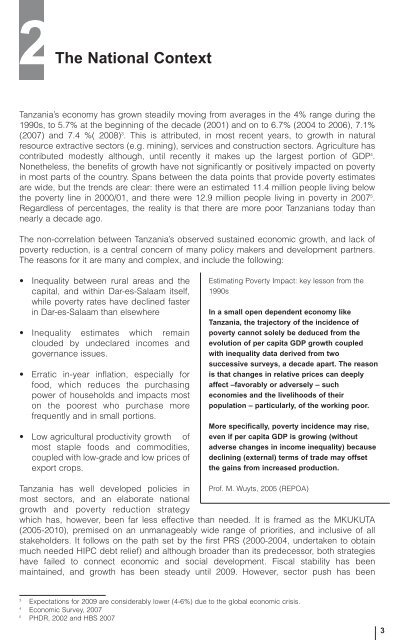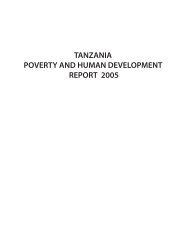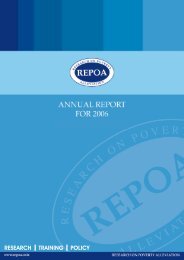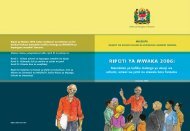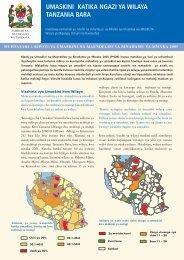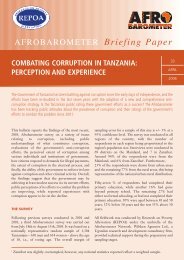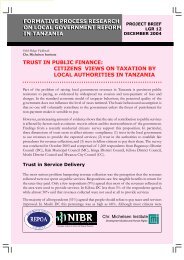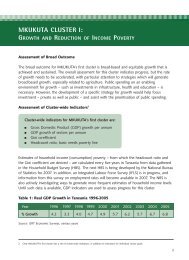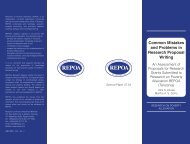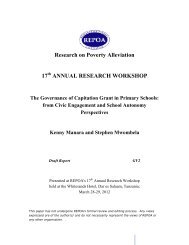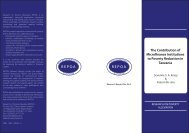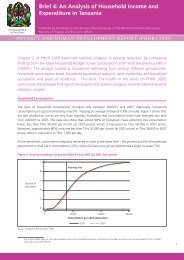Energy, Jobs and Skills - Repoa
Energy, Jobs and Skills - Repoa
Energy, Jobs and Skills - Repoa
Create successful ePaper yourself
Turn your PDF publications into a flip-book with our unique Google optimized e-Paper software.
2<br />
The National Context<br />
Tanzania’s economy has grown steadily moving from averages in the 4% range during the<br />
1990s, to 5.7% at the beginning of the decade (2001) <strong>and</strong> on to 6.7% (2004 to 2006), 7.1%<br />
(2007) <strong>and</strong> 7.4 %( 2008) 3 . This is attributed, in most recent years, to growth in natural<br />
resource extractive sectors (e.g. mining), services <strong>and</strong> construction sectors. Agriculture has<br />
contributed modestly although, until recently it makes up the largest portion of GDP 4 .<br />
Nonetheless, the benefits of growth have not significantly or positively impacted on poverty<br />
in most parts of the country. Spans between the data points that provide poverty estimates<br />
are wide, but the trends are clear: there were an estimated 11.4 million people living below<br />
the poverty line in 2000/01, <strong>and</strong> there were 12.9 million people living in poverty in 2007 5 .<br />
Regardless of percentages, the reality is that there are more poor Tanzanians today than<br />
nearly a decade ago.<br />
The non-correlation between Tanzania’s observed sustained economic growth, <strong>and</strong> lack of<br />
poverty reduction, is a central concern of many policy makers <strong>and</strong> development partners.<br />
The reasons for it are many <strong>and</strong> complex, <strong>and</strong> include the following:<br />
• Inequality between rural areas <strong>and</strong> the<br />
capital, <strong>and</strong> within Dar-es-Salaam itself,<br />
while poverty rates have declined faster<br />
in Dar-es-Salaam than elsewhere<br />
• Inequality estimates which remain<br />
clouded by undeclared incomes <strong>and</strong><br />
governance issues.<br />
• Erratic in-year inflation, especially for<br />
food, which reduces the purchasing<br />
power of households <strong>and</strong> impacts most<br />
on the poorest who purchase more<br />
frequently <strong>and</strong> in small portions.<br />
• Low agricultural productivity growth of<br />
most staple foods <strong>and</strong> commodities,<br />
coupled with low-grade <strong>and</strong> low prices of<br />
export crops.<br />
Estimating Poverty Impact: key lesson from the<br />
1990s<br />
In a small open dependent economy like<br />
Tanzania, the trajectory of the incidence of<br />
poverty cannot solely be deduced from the<br />
evolution of per capita GDP growth coupled<br />
with inequality data derived from two<br />
successive surveys, a decade apart. The reason<br />
is that changes in relative prices can deeply<br />
affect –favorably or adversely – such<br />
economies <strong>and</strong> the livelihoods of their<br />
population – particularly, of the working poor.<br />
More specifically, poverty incidence may rise,<br />
even if per capita GDP is growing (without<br />
adverse changes in income inequality) because<br />
declining (external) terms of trade may offset<br />
the gains from increased production.<br />
Tanzania has well developed policies in Prof. M. Wuyts, 2005 (REPOA)<br />
most sectors, <strong>and</strong> an elaborate national<br />
growth <strong>and</strong> poverty reduction strategy<br />
which has, however, been far less effective than needed. It is framed as the MKUKUTA<br />
(2005-2010), premised on an unmanageably wide range of priorities, <strong>and</strong> inclusive of all<br />
stakeholders. It follows on the path set by the first PRS (2000-2004, undertaken to obtain<br />
much needed HIPC debt relief) <strong>and</strong> although broader than its predecessor, both strategies<br />
have failed to connect economic <strong>and</strong> social development. Fiscal stability has been<br />
maintained, <strong>and</strong> growth has been steady until 2009. However, sector push has been<br />
3<br />
Expectations for 2009 are considerably lower (4-6%) due to the global economic crisis.<br />
4<br />
Economic Survey, 2007<br />
5<br />
PHDR, 2002 <strong>and</strong> HBS 2007<br />
3


